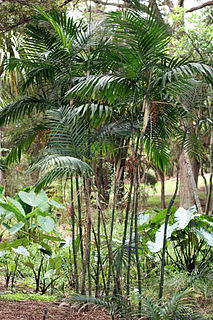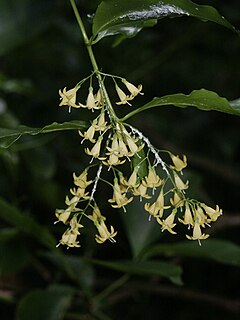
A forest is an area of land dominated by trees. Hundreds of definitions of forest are used throughout the world, incorporating factors such as tree density, tree height, land use, legal standing, and ecological function. The United Nations' Food and Agriculture Organization (FAO) defines a forest as, "Land spanning more than 0.5 hectares with trees higher than 5 meters and a canopy cover of more than 10 percent, or trees able to reach these thresholds in situ. It does not include land that is predominantly under agricultural or urban use." Using this definition, Global Forest Resources Assessment 2020 found that forests covered 4.06 billion hectares, or approximately 31 percent of the world's land area in 2020.
Arthrostylidium is a Neotropical genus of climbing bamboo in the grass family. the species are native to Central America, the West Indies, northern South America, and southern Mexico.

Guadua is a Neotropical genus of thorny, clumping bamboo in the grass family, ranging from moderate to very large species.

Chamaedorea is a genus of 107 species of palms, native to subtropical and tropical regions of the Americas. They are small palms, growing to 0.3–6 m tall with slender, cane-like stems, growing in the understory in rainforests, and often spreading by means of underground runners, forming clonal colonies. The leaves are pinnate, with one to numerous leaflets. The flowers are produced in inflorescences; they are dioecious, with male and female flowers on separate plants. The fruit is an orange or red drupe 0.5–2 cm diameter. Perhaps the best-known species is Chamaedorea elegans from Mexico and Guatemala. It is popular as a houseplant, particularly in Victorian houses. Another well-known species is Chamaedorea seifrizii, the bamboo palm or reed palm.
The following outline is provided as an overview of and guide to forestry:

Dypsis is a genus of flowering plants in the family Arecaceae. They are slender, evergreen palms with yellow flowers carried in panicles amongst the pinnate leaves. Many Dypsis species have aerial branching, a rare growth habit among palms. Some have marcescent leaves that remain attached after death and trap litter for nutrients.

The Kerala Forest Research Institute (KFRI) is an organisation based in Peechi, in Thrissur, India. It was established in 1975 by the Government of Kerala as part of its Science and Technology Department, and in 2003 became part of the Kerala State Council for Science, Technology and Environment.

Chiococca alba is a species of flowering plant in the coffee family (Rubiaceae) native to Florida and the extreme southern tip of Texas in the United States, Bermuda, Mexico, Central America, the Caribbean, the Galápagos, and tropical South America. Common names include David's milkberry, West Indian milkberry, cahinca and West Indian snowberry. The specific epithet, alba, means "white" in Latin and refers to the color of its fruits.
Arthrostylidium distichum is a species of Arthrostylidium bamboo native to Central America, the West Indies, northern South America, and southern Mexico.
Arthrostylidium chiribiquetense is a species of Neotropical bamboo native to Central America, the West Indies, northern South America, and southern Mexico.
Arthrostylidium cubense is a species of Arthrostylidium bamboo native to Central America, the West Indies, northern South America, and southern Mexico.
Arthrostylidium fimbriatum is a species of Arthrostylidium bamboo in the grass family. The species are native to Central America, the West Indies, northern South America, and southern Mexico.
Arthrostylidium fimbrinodum is a species of Arthrostylidium bamboo in the grass family. The species is native to Central America, the West Indies, northern South America, and southern Mexico.
Arthrostylidium grandifolium is a species of Arthrostylidium bamboo in the grass family. The species is native to Central America, the West Indies, northern South America, and southern Mexico.
Arthrostylidium haitiense is a species of Arthrostylidium bamboo in the grass family. The species is native to Central America, the West Indies, northern South America, and southern Mexico.
Arthrostylidium sarmentosum is a species of Arthrostylidium bamboo in the grass family. The species is native to Central America, the West Indies, northern South America, and southern Mexico.
Arthrostylidium simpliciusculum is a species of Arthrostylidium bamboo in the grass family.
Ximena Londoño de la Pava is a Colombian botanist, specializing in agrostology. She has done extensive research on the bamboo genus Guadua in South America and Central America.





